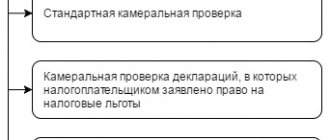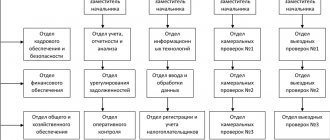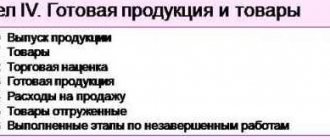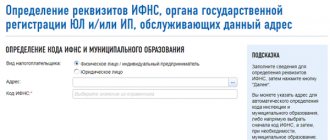An on-site tax audit is a procedure familiar to almost any entrepreneur. Quite troublesome, diverting time and labor resources, and very risky, the results of which determine the future life of the enterprise, as well as possibly other negative aspects associated with the responsibility of the managers and founders of the enterprise.
By the way, on the tax authorities’ website, GNP is called a useful procedure.
Why useful?
But because, as our apologists for the usefulness of GNP write, the procedure is usually carried out (?!) by deeply competent employees of the tax authorities, and upon completion the entrepreneur will receive a substantiated report on the company’s violations in the field of taxation and accounting. In fact, tax specialists will perform a free audit of the organization. After familiarizing yourself with the mistakes made, the entrepreneur will simply need to structure his work in such a way as to prevent their repetition in the future. That's it, dear entrepreneurs. For you, from the point of view of tax authorities, this is very, very useful!
However, this is all later, and first, any businessman would benefit from detailed knowledge of exactly how this procedure is carried out.
Concept for planning on-site tax audits
In order to monitor taxpayers' compliance with the legislation on taxes and fees, the Federal Tax Service authorities are vested with the right to conduct on-site tax audits (ATI).
Making a decision to conduct an on-site tax audit in relation to a certain person does not occur spontaneously and solely at the request of the inspection inspector. This decision is determined by the presence of certain factors and circumstances, the understanding of which will allow you with a high degree of probability to understand whether to expect an inspection soon or not.
The aforementioned Order of the Federal Tax Service of the Russian Federation dated May 30, 2007 No. MM-3-06/ [email protected] , since Appendix 2 contains criteria for self-assessment of risks for taxpayers. We wrote about how to use these criteria in the article “Tax burden by type of activity: the Federal Tax Service is coming to us.”
How will the monitoring system be developed?
The concept defines the following main directions for the development of tax monitoring:
- creation of a new system of mandatory requirements for voluntary compliance with the legislation of the Russian Federation on taxes and fees through the integration of tax control into the organizational and information environment of payers with the simultaneous refusal of tax audits;
- development of expanded information interaction by organizing access of tax authorities to information systems of payers in real time and moving to a qualitatively new level of document (information) processing while simultaneously abandoning a complete documentary check and requesting primary documents of payers in respect of which tax monitoring is carried out, giving legal the significance of the fact of submitting documents (copies thereof) to the Federal Tax Service by organizing the tax authority’s access to the payer’s information systems;
- development of a risk-based approach based on uniform standards for the creation and development of risk management systems, including the transition to joint risk assessment based on timely informing payers about identified risks and receiving feedback from the payer to assess the effectiveness of the risk management system;
- development of interactive services, open software interfaces and analytical tools that provide automation of tax control through remote launch of an automatic control program in the information systems of payers, to which tax authorities are given access;
- creating conditions for increasing the level of trust of tax authorities in payers' information systems, as well as internal control and risk management systems based on checking the compliance of these systems with established requirements, testing and assessing the level of their organization;
- further development and improvement of the mechanism for coordination by tax authorities of the tax base in order to increase the level of predictability of revenues from taxes, fees and insurance contributions to the budget;
- increasing the efficiency of procedures for resolving controversial issues using motivated opinions of the tax authority.
The concept also defines the following activities:
- expanding the list of payers who have the right to apply to the tax authority to conduct tax monitoring, by changing the conditions that the payer must comply with;
- refusal to conduct tax audits and reduction of tax control periods;
- development of expanded information interaction by organizing access for tax authorities to information systems of payers in real time and moving to a qualitatively new level of document (information) processing;
- development of a risk-based approach in tax control;
- further integration of tax control into payers’ information systems;
- confirmation of compliance of payers’ information systems to which tax authorities are provided, as well as payers’ internal control and risk management systems with established requirements;
- development of the institution of motivated opinions of tax authorities.
Making a decision to conduct a pre-screening analysis (PVA) in relation to a person
One way or another, the Federal Tax Service checks all taxpayers. And the very first filter is to determine the circle of persons in respect of whom the PPA will be carried out.
The selection of taxpayers for conducting an on-site tax audit is carried out by the fiscal authorities on the basis of:
- Order of the Federal Tax Service of Russia dated May 30, 2007 No. MM-3-06/ [email protected] “On approval of the Concept of the planning system for on-site tax audits”, which defines 12 criteria that negatively characterize the taxpayer;
- information regarding a specific taxpayer received from a higher body of the Federal Tax Service (UFTS of Russia for the subject);
- information regarding a specific taxpayer received from other departments of the inspectorate (for example, from the desk tax audit department).
The decision to carry out a PPA in relation to a tax payer is not formalized, it occurs on a routine basis and the payer himself is not informed about it.
Objectives of the Concept
The document under consideration is aimed at:
- improving the quality and efficiency of tax control based on high-tech solutions;
- simplification and facilitation of interaction between tax authorities and organizations (taxpayers, fee payers, insurance premium payers and/or tax agents);
- increasing transparency of payers' activities.
The main goal of the Concept is to determine ways and means of digitalization of tax control based on the use of a risk-based approach aimed at verifying high-risk transactions of payers, taking into account industry specifics, with the subsequent integration of the function of state tax control into the corporate information systems of payers. This will ensure:
- voluntary, correct and timely payment of taxes, fees and insurance contributions to the budget;
- increasing the efficiency of tax control;
- reduction of the administrative burden for payers (refusal of tax audits, reduction of time frames for tax control activities).
The state, represented by the Ministry of Finance and the Federal Tax Service, wants to better understand the business models and industry specifics of the activities of payers, as well as reduce the number of disputes by developing tools for harmonizing the tax base.
Carrying out PPA in relation to a person
If your company eventually comes to the attention of the tax authorities for the reasons described above, this does not mean that an IRR is guaranteed to be carried out against it. Today, the Federal Tax Service is rightfully faced with the task of increasing the efficiency of control in the area of accrual and payment of taxes and fees. This means that before making a decision to conduct a tax return, the fiscal authority must already have preliminary information about potential violations of tax laws by a person, as well as the possibility of actually collecting from him the expected amounts of additional taxes, penalties and fines.
It is for this purpose that a PPA is carried out in relation to taxpayers, within the framework of which the Federal Tax Service authorities use the following tools and sources of information:
- Request information from other government bodies (Federal Customs Service of Russia, Rosimushchestvo, Ministry of Internal Affairs, etc.).
- Requesting information from the taxpayer's counterparties and banks in accordance with Art. 93.1 Tax Code of the Russian Federation.
- Information about the taxpayer from general information sources on the Internet.
- Information about court cases involving taxpayers.
- Some control measures provided for in Ch. 14 of the Tax Code of the Russian Federation (inspection of premises, requesting explanations, etc.).
- Use of specialized information resources of the Federal Tax Service (for example):
- ASK VAT-2 allows you to install the so-called. “tax gap” in the VAT chain;
- PIK "Odnodnevka" - a database of "technical" companies;
- FIR (federal information resource) - database of interrogations, examinations, 2-NDFL certificates;
- PC "VAI" (visual information analyzer) - identifies interdependent persons, sources of their income and other information.
Based on the results of the PPA, a conclusion is issued that reflects the following information:
- The feasibility of conducting a GNP.
- Recommended plan of activities that will need to be carried out within the framework of the GNP.
- Recommendations on the composition of inspectors (including the need to include representatives of law enforcement agencies in their composition).
- The potential amount of additional charges based on the results of the GNP.
- Possibility of actual recovery of additional amounts accrued based on the results of the GNP.
Order of the Federal Tax Service of the Russian Federation dated May 30, 2007 No. MM-3-06/ [email protected]
This Concept provides for the taxpayer to conduct an independent risk assessment based on the results of its financial and economic activities according to the criteria given below.
Publicly available criteria for self-assessment of risks for taxpayers, used by tax authorities in the process of selecting objects for conducting on-site tax audits, may be:
1. The tax burden of a given taxpayer is below its average level for business entities in a specific industry (type of economic activity).
2. Reflection in accounting or tax reporting of losses over several tax periods.
3. Reflection in tax reporting of significant amounts of tax deductions for a certain period.
4. The growth rate of expenses exceeds the growth rate of income from the sale of goods (works, services).
5. Payment of average monthly wages per employee below the average level for the type of economic activity in the constituent entity of the Russian Federation.
6. Repeatedly approaching the maximum value of the indicators established by the Tax Code of the Russian Federation that grant taxpayers the right to apply special tax regimes.
7. Reflection by an individual entrepreneur of the amount of expenses as close as possible to the amount of his income received for the calendar year.
8. Construction of financial and economic activities based on concluding agreements with counterparties-resellers or intermediaries (“chains of counterparties”) without reasonable economic or other reasons (business purpose).
9. Failure by the taxpayer to provide explanations to the notification of the tax authority about the identification of discrepancies in performance indicators, and (or) failure to provide the tax authority with the requested documents, and (or) the availability of information about their destruction, damage, etc.
(Clause as amended, put into effect by Order of the Federal Tax Service of Russia dated May 10, 2012 No. ММВ-7-2/ [email protected] – See previous edition.)
10. Repeated deregistration and registration with the tax authorities of the taxpayer in connection with a change in location (“migration” between tax authorities).
11. Significant deviation of the level of profitability according to accounting data from the level of profitability for a given field of activity according to statistics.
12. Conducting financial and economic activities with high tax risk.
When assessing the above indicators, the tax authority necessarily analyzes the possibility of extracting or the presence of an unjustified tax benefit, including under the circumstances specified in the Resolution of the Plenum of the Supreme Arbitration Court of the Russian Federation dated October 12, 2006 No. 53.
Systematic self-assessment of risks based on the results of its financial and economic activities will allow the taxpayer to timely assess tax risks and clarify their tax obligations.
How to assess the risk of a tax audit: 12 criteria
We analyze 12 risk criteria for tax audits. We show how to analyze criteria in the 1C: Accounting 8 program, ed. 3.0.
According to paragraphs. 2 p. 1 art. 32 of the Tax Code of the Russian Federation, tax authorities are obliged to monitor taxpayer compliance with legislation on taxes and fees. The form of such control is an on-site tax audit of the taxpayer, the right to conduct which is enshrined in paragraphs. 2 p. 1 art. 31 Tax Code of the Russian Federation.
The main document for conducting on-site tax audits is Order of the Federal Tax Service of Russia dated May 30, 2007 No. MM-3-06/ [email protected] (as amended on May 10, 2012) “On approval of the Concept of the planning system for on-site tax audits”
.
When planning on-site audits, tax specialists are guided by the values of publicly available criteria, which are automatically displayed in their program. There are 12 criteria in total. A taxpayer who meets these risk criteria will most likely be included in the on-site tax audit plan.
In order not to attract increased attention from tax authorities to your company, it is advisable for an accountant or manager to independently monitor these criteria.
Don't want to read? Watch the video for 15 minutes.
At the webinar, Olga Slavnina, leading specialist of the consultation line, told how to independently assess the risk of a tax audit using 12 criteria.
Watch the video
12 criteria for assessing tax risks
Criterion No. 1
. The taxpayer's tax burden is lower than the average level of tax burden for business entities in the selected industry (in the selected type of economic activity).
The calculation of the tax burden, starting from 2006, for the main types of economic activity, is set out in Appendix No. 3 to Order of the Federal Tax Service of Russia dated May 30, 2007 N MM-3-06/ [email protected]
The tax burden is calculated as the ratio of the amount of taxes paid (according to the reporting of tax authorities) and the turnover (revenue) of organizations (according to Rosstat).
Criterion No. 2
. For 2 or more years, the organization reflects a loss in its accounting and tax reporting.
Criterion No. 3
. The share of value added tax deductions is greater than or equal to 89% for a period of 12 months. The criterion is important for organizations that apply the general taxation system (GTS).
In general, for the Russian Federation at the end of 2022, updated indicators for the current date are presented in the table:
Rice. 1 (click to enlarge)
Current data for the Sverdlovsk region:
Rice. 2 (click to enlarge)
Criterion No. 4
. Expense growth is outpacing income growth. The criterion is important for organizations that apply the general taxation system (GTS).
Criterion No. 5
. The salary of an employee of the selected organization is lower than the average level for a similar type of activity in the region.
Criterion No. 6
. Repeated (more than 1 time) approach to the extreme value of such indicators as revenue, number of employees, residual value of fixed assets, which give the right to apply a special regime (STS). An approximation of 5% or less is taken into account.
Criterion No. 7
. An entrepreneur for the year in the book of income and expenses reflects the amounts of expenses as close as possible to the amount of income.
Criterion No. 8
. Building a business on the basis of concluding business agreements with counterparties-resellers or intermediaries (“chains of counterparties”) without reasonable economic or other reasons (business purpose).
Criterion No. 9
. Ignoring the requirements of tax authorities: failure by the taxpayer to provide explanations for notifying the tax authority about the identification of discrepancies in performance indicators, and/or failure to provide the tax authority with the requested documents, etc.
Criterion No. 10
. Multiple deregistration with one tax authority and registration with other tax authorities by the taxpayer due to a change in location (frequent movement between tax authorities).
Criterion No. 11
. The level of return on sales and assets (according to financial statements) differs by more than 10% from the level of return on sales and assets of similar enterprises in the same field of activity (according to statistics).
Criterion No. 12
. Conducting financial and economic activities with increased tax risk.
When assessing tax risks that may be associated with relationships with certain counterparties, the taxpayer is recommended to pay attention to the following points:
- lack of direct personal contacts between the management (authorized officials) of the supplier company and the company management (authorized officials);
- lack of information about the actual address of the counterparty, as well as the location of warehouse and/or production and/or retail space;
- lack of information about the counterparty in open sources (no advertising in the media, no recommendations from partners or other persons, no website of the counterparty, etc.);
- lack of information about the state registration of the counterparty in the Unified State Register of Legal Entities.
The presence of these signs indicates a high degree of risk of classifying such a counterparty by the tax authorities as problematic or “fly-by-night,” and transactions made with such a counterparty are questionable.
Check the reliability of your counterparties using the 1SPARK Risks
. Free trial period – 7 days. Find out details
Risk assessment in the 1C program
In the program "1C: Accounting 8", ed. 3.0 you can independently analyze and assess the likelihood of a tax audit. The program takes average data for 12 indicators in your industry (for example, average salary) and compares them with similar indicators for your company.
The “Tax Audit Risk Assessment” report, which is located on the “Reports” tab, is intended for these purposes. Using the report, an analysis is carried out according to twelve criteria given in the “Concept of a planning system for on-site tax audits”.
Checking for compliance with these criteria is carried out using the data contained in the database and according to data from previously created regulated reporting in the information base. The report can be generated for the 1st quarter, half a year, 9 months, or a year.
You can find the report in the Reports
—
Accounting analysis
—
Tax audit risk assessment
.
Rice. 3 (click to enlarge)
Select the period for assessing the audit risk, the organization (if the information base keeps records of several organizations) and click the “Perform check” button.
To obtain detailed information on each item, we will expand it by the plus sign.
The report can be printed using the “Print” button.
Rice. 4 (click to enlarge)
Problematic criteria are marked with red exclamation marks. For example, for our organization this is the third criterion - there are significant VAT deductions:
Rice. 5 (click to enlarge)
Expanding the item, we see that the safe percentage of VAT deduction (89%) has been exceeded, which means there is a basis for additional verification. Also in this example, questions arose regarding criterion No. 11 – profitability is below the industry limit:
Rice. 6 (click to enlarge)
But with the salary (criterion No. 5) everything is in order:
Rice. 7 (click to enlarge)
Some criteria may be impossible to analyze using program data; in this case, they are marked with orange circles with question marks and contain an explanation.
Rice. 8 (click to enlarge)
If you haven't worked with this report yet, we recommend that you familiarize yourself with it and analyze your organization's performance. Data for analysis will be taken into account based on the results of previously created reporting. Please note that this estimate is approximate and does not guarantee that inspections will be excluded.
| “Successful work in 1C programs. Let tax audits bypass you! » Olga Slavnina, leading specialist of the consultation line of Support Center LLC, author of the article. Order a consultation |
Along with this read:
- How to protect yourself during a tax audit
- Check the counterparty and conduct business without risks
9852 views
Main directions of tax policy for 2022
So, what can we expect from the state in 2022:
- Improving tax administration.
- New tax regime. See details here.
- Creation of a code of non-tax payments.
- Reductions in federal benefits and transfer of authority to establish benefits to the regional (local) level.
- Changes in tax legislation affecting either certain categories of taxpayers or certain transactions for various types of taxes.
- It is proposed to increase the maximum cost of advertising materials for VAT exemption from 100 to 300 rubles.
In general, the state's tax policy continues the course begun in previous years.







